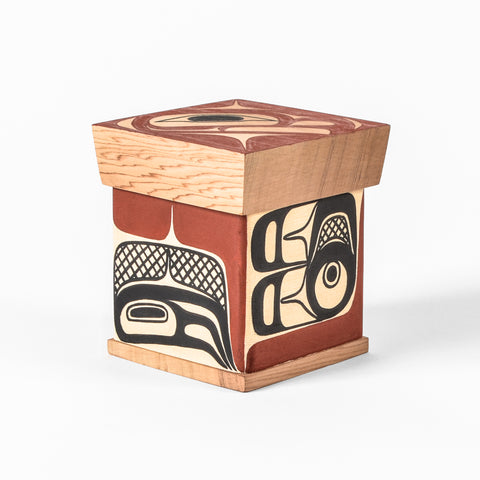David A. Boxley
CULTURAL GROUP:
Tsimshian
BORN:
1952
BIRTHPLACE:
Metlakatla, Alaska
David Boxley is an artist of national prominence, noted both as a carver and a performer in Tsimshian dance. He attended Seattle University, where he received a Bachelor of Science degree in 1974. Afterwards, he became a Junior and Senior High School teacher, and basketball coach in Metlakatla in 1979. At this time, he began to study traditional Tsimshian carving techniques. In 1982, he carved the first pole to be raised in the town of Metlakatla. In 1986, he made a major career change toward carving and researching Northwest Coast art. Since this time, he has exhibited his work in many different countries worldwide, received many commissions, and has taught and demonstrated at museums worldwide. David has also been deeply involved with the rebirth of Tsimshian culture through organizing and hosting Potlatches in Alaska and Washington. He was responsible for the 1996 Seattle Northwest Coast Potlatch, the first in one hundred years. David also has been directly involved in the formation of two successful dance groups in Metlakatla, Alaska, and Seattle, Washington. He is the leader of the Tsimshian Haayuuk in Seattle, and has written over 25 songs in his native language. In 1990, Boxley was commissioned to carve the crown of a talking stick depicting a Russian Bear and an American Eagle as a symbol of peace and harmony between the USA and Soviet Union for the Goodwill Games. Messages from both presidents, George Bush and Mikhail Gorbachev, were placed inside of the talking stick, and athletes carried the stick from Spokane through Washington, Oregon, and onto Seattle for the opening ceremonies. In 2015, David and his son, David R. Boxley, were commissioned by the Sealaska Heritage Institute to create one of three monumental works of art for the Walter Soboloff Building representing Alaska's three tribes: Tlingit, Haida, Tsimshian. It was a caved and painted longhouse front.

